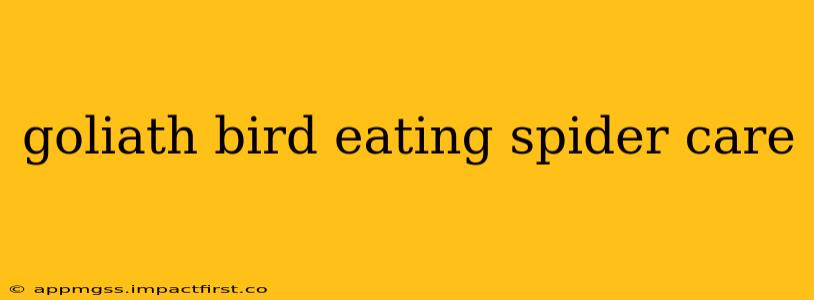The Goliath bird-eating spider ( Theraphosa blondi ) is a truly magnificent creature, captivating arachnophiles and sparking both fascination and fear in others. Its size—a leg span that can reach up to 12 inches—makes it the largest spider species in the world by mass. However, owning such a formidable arachnid requires considerable commitment and understanding. This comprehensive guide delves into the intricacies of Goliath bird-eating spider care, ensuring you provide the best possible environment for this impressive invertebrate.
What Do Goliath Bird-Eating Spiders Eat?
Goliath bird-eating spiders, despite their name, don't primarily subsist on birds. Their diet mainly consists of insects, such as crickets, roaches, and mealworms. Larger specimens might occasionally consume small rodents or lizards, but these shouldn't form the staple of their diet. The size of the prey should be proportional to the spider's size; a juvenile spider will need smaller insects than an adult. Providing a varied diet is crucial for their health and well-being. Remember, providing sufficient food is a key component of proper Goliath bird-eating spider care.
How Big Do Goliath Bird-Eating Spiders Get?
As mentioned, Goliath bird-eating spiders boast impressive dimensions. Their leg span can reach up to 12 inches, but their body length is generally smaller, around 4-5 inches. Females tend to be larger than males. Reaching their full size takes several years, with growth slowing down significantly as they mature. Understanding their growth rate allows for appropriate adjustments in enclosure size and prey selection over their lifespan.
How Long Do Goliath Bird-Eating Spiders Live?
Female Goliath bird-eating spiders can live for 15-25 years, significantly longer than their male counterparts. Males typically reach maturity earlier and have a shorter lifespan of only 3-6 years. This disparity highlights the importance of sex identification during purchase, which can be challenging for less experienced keepers. Providing optimal care conditions directly influences their lifespan; a healthy environment contributes to longevity.
Goliath Bird-Eating Spider Enclosure Setup:
Providing a suitable enclosure is paramount for a Goliath bird-eating spider's health and well-being. A large terrarium is essential, at least 24 inches x 18 inches x 18 inches for an adult, with adequate ventilation. The substrate should be a mix of peat moss and coconut fiber, providing a suitable burrowing environment. A water dish should always be present, ensuring hydration. Avoid overcrowding; one spider per enclosure is recommended. Hiding places, such as cork bark or half-logs, provide security and reduce stress. Maintain a consistent temperature and humidity; around 75-80°F and 70-80% humidity are ideal.
How Often Should I Handle My Goliath Bird-Eating Spider?
While tempting to interact with such a magnificent creature, handling a Goliath bird-eating spider is strongly discouraged. Their urticating hairs—tiny, barbed hairs they can flick—can cause significant skin irritation. Their fangs are also capable of delivering a painful bite, although generally not medically significant. Observation is preferable to handling; appreciate their beauty and behaviors from a safe distance. Their stress levels greatly increase with handling, negatively affecting their overall health.
Are Goliath Bird-Eating Spiders Poisonous?
Goliath bird-eating spiders are venomous, not poisonous. Venom is injected through a bite, whereas poison is absorbed through the skin. While their venom is not considered medically significant to humans, a bite can be painful and cause localized swelling. Proper handling techniques—meaning no handling at all—are essential to avoid any potential incident. This is a crucial safety aspect for all potential keepers.
How Much Does a Goliath Bird-Eating Spider Cost?
The cost of a Goliath bird-eating spider varies depending on the vendor, age, and size. Expect to pay several hundred dollars. Factor in the ongoing costs of enclosure setup, substrate, prey, and potential veterinary care should an issue arise. Responsible ownership involves a significant financial commitment beyond the initial purchase price.
Conclusion:
Keeping a Goliath bird-eating spider is a rewarding but demanding endeavor. Prioritize responsible ownership, including thorough research, a suitable enclosure, and proper diet. Remember that observation, rather than handling, offers the best way to appreciate these magnificent creatures. By following this comprehensive guide, you can ensure your Goliath bird-eating spider thrives in captivity for many years.
